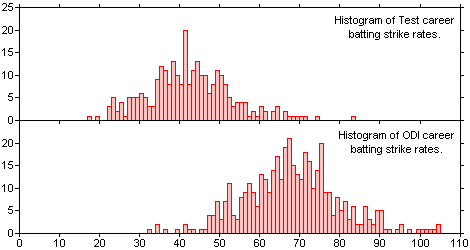Strike rate
Strike rate refers to two different statistics in the sport of cricket. Batting strike rate is a measure of how frequently a batsman achieves the primary goal of batting, namely scoring runs. Bowling strike rate is a measure of how frequently a bowler achieves the primary goal of bowling, namely taking wickets (i.e. getting batsmen out).
Both strike rates are relatively new statistics, having only been invented and considered of importance after the introduction of One Day International cricket in the 1970s.
Batting strike rate

Batting strike rate is defined for a batsman as the average number of runs scored per 100 balls faced. The higher the strike rate, the more effective a batsman is at scoring quickly.
In Test cricket, a batsman's strike rate is of secondary relevance to his ability to score runs without getting out. This means a Test batsman's most important statistic is generally considered to be his batting average, rather than his strike rate.
In limited overs cricket, strike rates are of considerably more importance. Since each team only faces a limited number of balls in an innings, the faster a batsman scores, the more runs his team will be able to accumulate. Strike rates of over 150 are becoming common in Twenty20 cricket.[1] Strike rate (s/r) is probably considered by most as the key factor in a batsman in one day cricket. Accordingly, the batsmen with the higher strike rate, especially in Twenty20 matches, are more valued than those with a lesser strike rates.
Bowling strike rate
Bowling strike rate is defined for a bowler as the average number of balls bowled per wicket taken. The lower the strike rate, the more effective a bowler is at taking wickets quickly.
Although introduced as a statistic complementary to the batting strike rate during the ascension of one-day cricket in the 1980s, bowling strike rates are arguably of more importance in Test cricket than One-day Internationals. This is because the primary goal of a bowler in Test cricket is to take wickets, whereas in a one-day match it is often sufficient to bowl economically - giving away as few runs as possible even if this means taking fewer wickets.
Best career strike rate (Tests)
| Strike rate | Player | Balls | Wickets | |
| 34.1 | 3,830 | 112 | ||
|---|---|---|---|---|
| 37.7 | 2,302 | 61 | ||
| 38.8 | 3,372 | 87 | ||
| 41.6 | 7,873 | 189 | ||
| 43.1 | 2,764 | 64 | ||
|
Qualification: 2,000 balls | ||||
| Strike rate | Player | Balls | Wickets | |
| 41.6 | 16,716 | 402 | ||
|---|---|---|---|---|
| 47.2 | 4,678 | 99 | ||
| 47.9 | 5,903 | 123 | ||
| 48.1 | 2,938 | 61 | ||
| 49.4 | 10899 | 220 | ||
|
Qualification: 2,000 balls | ||||
References
- ↑ Cricinfo Twenty20 Internationals Highest career batting strike rates
- 1 2 "Test matches – Bowling records – Best career strike rate". Cricinfo. ESPN. Retrieved 19 August 2015.